Table of contents
- Moto Guzzi V2 purchase advice High-displacement twins from the 1970s and 1980s
- Reconstruction orgies with Moto Guzzi Le Mans
- Careful warm-up phase is extremely important
- Common ailment: oil loss
- Valve train is considered robust
- All parts available for carburettors
- Lots of chic tuning accessories for the Dellortos
- Clutch often with plaque
- Problem child cardan
- Better than its reputation: the electrics
- Overhaul of the starter
- Difficulty with contact ignition
- Stable to this day: the chassis
- Other signs of aging
- The experts
- That’s what the restorer means
- Moto Guzzi Le Mans IV is still being traded cheaply
- market
- Screwdriver skills
- More Moto Guzzi specialists

archive
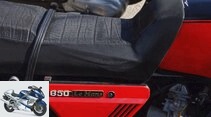
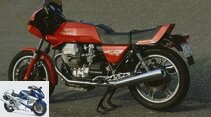
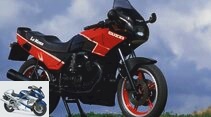
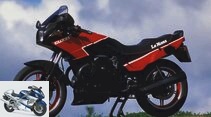
36 pictures
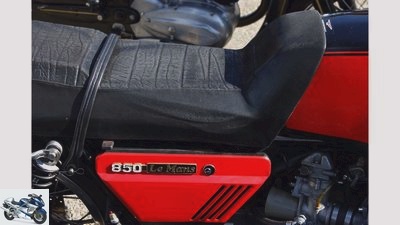
archive
1/36
Buying advice: What to look for when buying a large-displacement Moto Guzzi twin from the 70s and 80s.
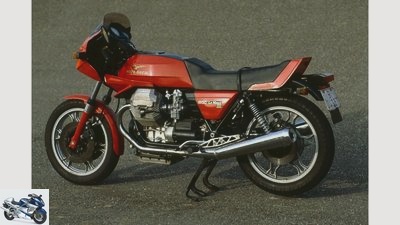
archive
2/36
Buying advice: What to look for when buying a large-displacement Moto Guzzi twin from the 70s and 80s.
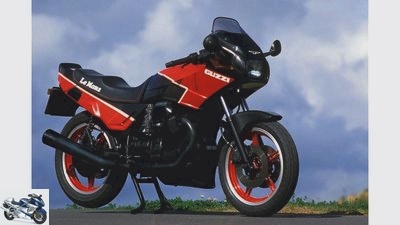
archive
3/36
Buying advice: What to look for when buying a large-displacement Moto Guzzi twin from the 70s and 80s.
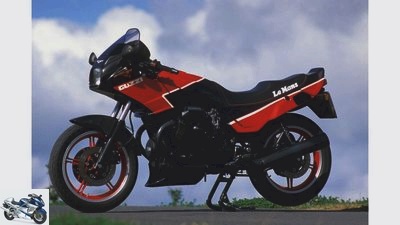
archive
4/36
Buying advice: What to look for when buying a large-displacement Moto Guzzi twin from the 70s and 80s.

archive
5/36
Buying advice: What to look for when buying a large-displacement Moto Guzzi twin from the 70s and 80s.
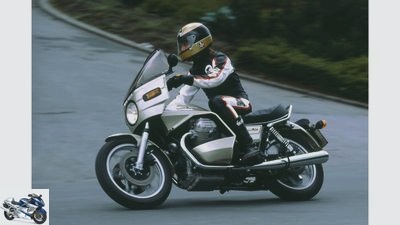
archive
6/36
Buying advice: What to look for when buying a large-displacement Moto Guzzi twin from the 70s and 80s.

archive
7/36
Buying advice: What to look for when buying a large-displacement Moto Guzzi twin from the 70s and 80s.
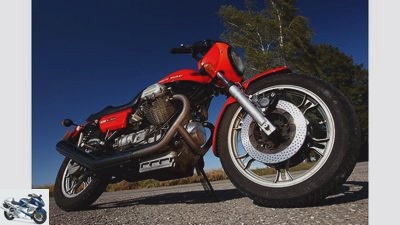
archive
8/36
Buying advice: What to look for when buying a large-displacement Moto Guzzi twin from the 70s and 80s.
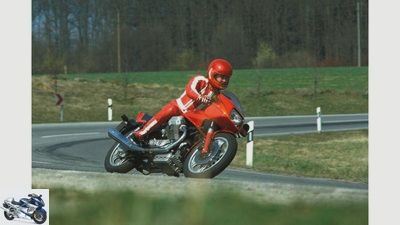
archive
9/36
Buying advice: What to look for when buying a large-displacement Moto Guzzi twin from the 70s and 80s.
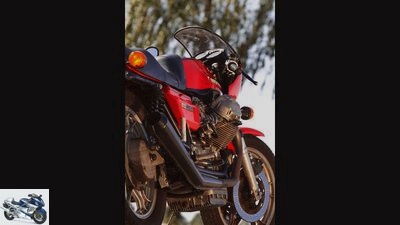
archive
10/36
Buying advice: What to look for when buying a large-displacement Moto Guzzi twin from the 70s and 80s.
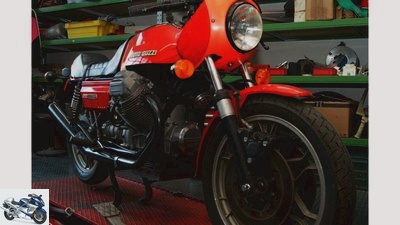
archive
11/36
Buying advice: What to look for when buying a large-displacement Moto Guzzi twin from the 70s and 80s.
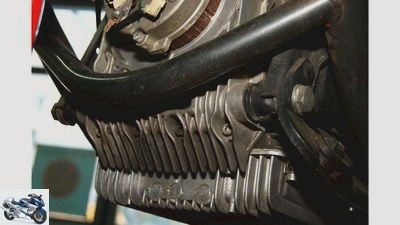
archive
12/36
Buying advice: What to look for when buying a large-displacement Moto Guzzi twin from the 70s and 80s.
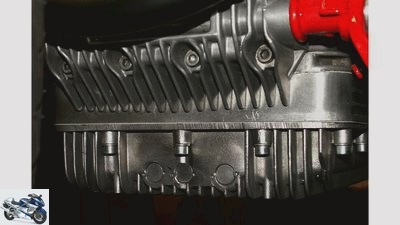
archive
13/36
Buying advice: What to look for when buying a large-displacement Moto Guzzi twin from the 70s and 80s.
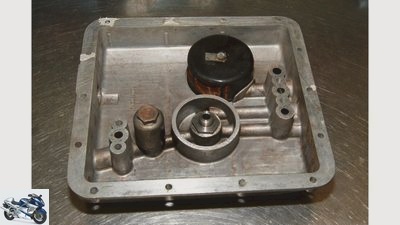
archive
14/36
Buying advice: What to look for when buying a large-displacement Moto Guzzi twin from the 70s and 80s.
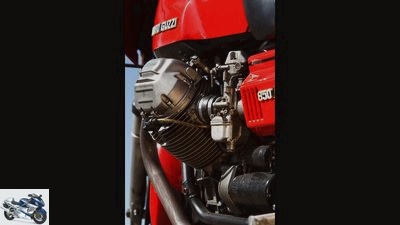
archive
15/36
Buying advice: What to look for when buying a large-displacement Moto Guzzi twin from the 70s and 80s.
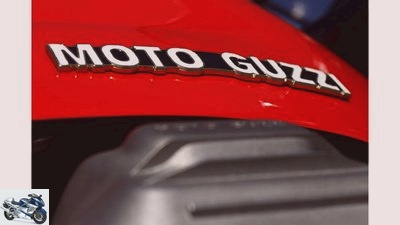
archive
16/36
Buying advice: What to look for when buying a large-displacement Moto Guzzi twin from the 70s and 80s.
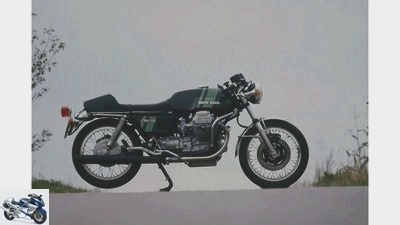
archive
17/36
Buying advice: What to look out for when buying a large-capacity twin from Moto Guzzi from the 70s and 80s.
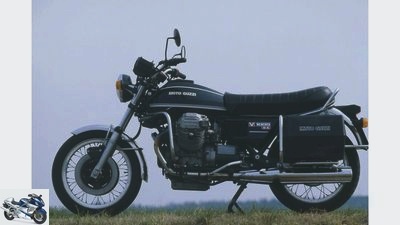
archive
18/36
Buying advice: What to look out for when buying a large-capacity twin from Moto Guzzi from the 70s and 80s.
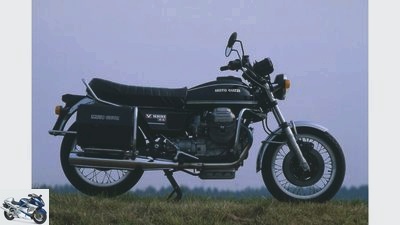
archive
19/36
Buying advice: What to look for when buying a large-displacement Moto Guzzi twin from the 70s and 80s.
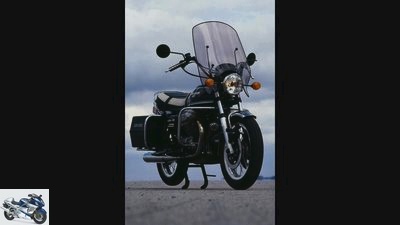
archive
20/36
Buying advice: What to look for when buying a large-displacement Moto Guzzi twin from the 70s and 80s.
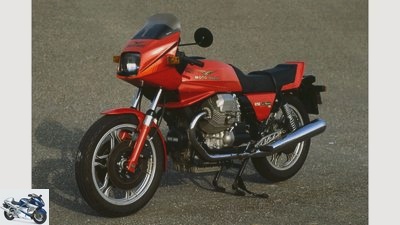
archive
21/36
Buying advice: What to look for when buying a large-displacement Moto Guzzi twin from the 70s and 80s.
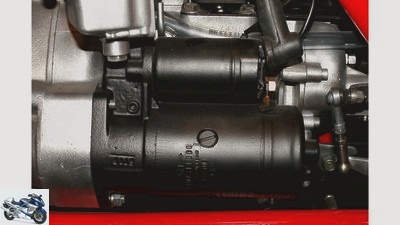
archive
22/36
Buying advice: What to look for when buying a large-displacement Moto Guzzi twin from the 70s and 80s.
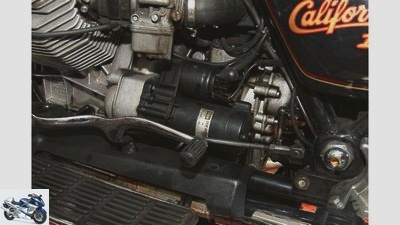
archive
23/36
Buying advice: What to look for when buying a large-displacement Moto Guzzi twin from the 70s and 80s.
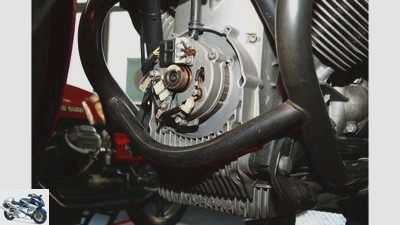
archive
24/36
Buying advice: What to look for when buying a large-displacement Moto Guzzi twin from the 70s and 80s.

archive
25/36
Buying advice: What to look for when buying a large-displacement Moto Guzzi twin from the 70s and 80s.

archive
26/36
Buying advice: What to look for when buying a large-displacement Moto Guzzi twin from the 70s and 80s.
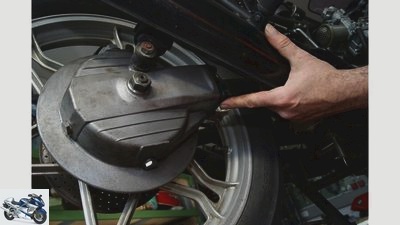
archive
27/36
Buying advice: What to look for when buying a large-displacement Moto Guzzi twin from the 70s and 80s.
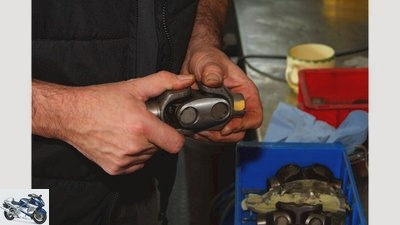
archive
28/36
Buying advice: What to look out for when buying a large-capacity twin from Moto Guzzi from the 70s and 80s.
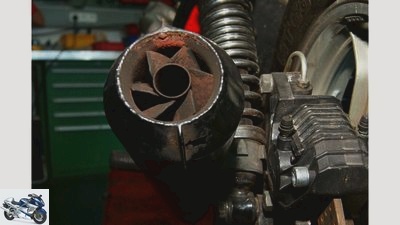
archive
29/36
Buying advice: What to look for when buying a large-displacement Moto Guzzi twin from the 70s and 80s.
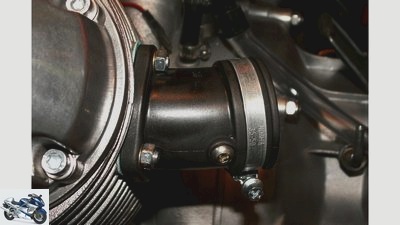
archive
30/36
Buying advice: What to look for when buying a large-displacement Moto Guzzi twin from the 70s and 80s.
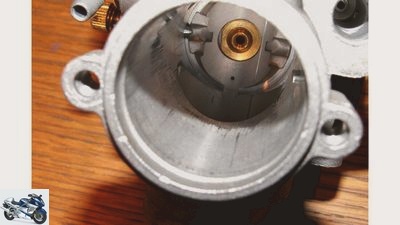
archive
31/36
Buying advice: What to look for when buying a large-displacement Moto Guzzi twin from the 70s and 80s.
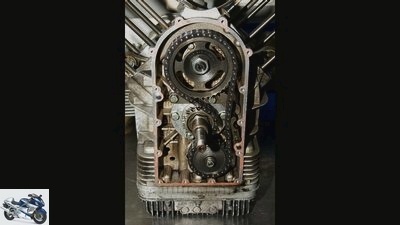
archive
32/36
Buying advice: What to look for when buying a large-displacement Moto Guzzi twin from the 70s and 80s.
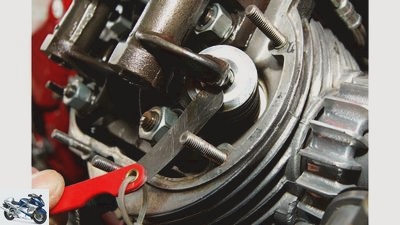
archive
33/36
Buying advice: What to look for when buying a large-displacement Moto Guzzi twin from the 70s and 80s.
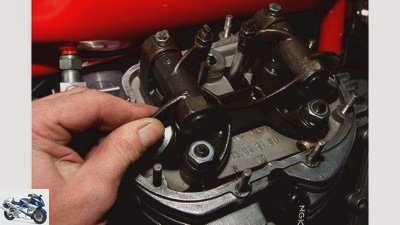
archive
34/36
Buying advice: What to look for when buying a large-displacement Moto Guzzi twin from the 70s and 80s.
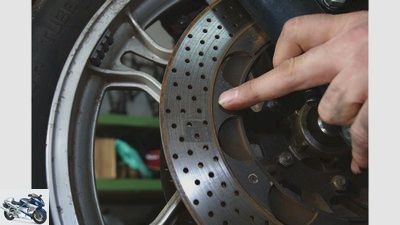
archive
35/36
Buying advice: What to look for when buying a large-displacement Moto Guzzi twin from the 70s and 80s.
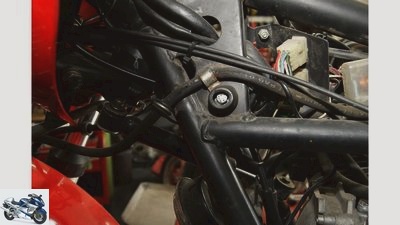
archive
36/36
Buying advice: What to look for when buying a large-displacement Moto Guzzi twin from the 70s and 80s.
counselor
Used purchase
Moto Guzzi V2 purchase advice
Moto Guzzi V2 purchase advice
High-displacement twins from the 1970s and 1980s
Content of
Constantly climbing prices for the Guzzi classics of the 1970s and 80s show the great importance of the high-displacement Twins from Mandello del Lario. We reveal what interested parties should look out for when buying a model from the diverse Moto Guzzi construction kit.
Marcel Schoch
02/21/2013
Hard as a board, sensitive, but beautiful – you often hear that at the regulars’ tables when over Moto Guzzi is talked about. Nevertheless, the big V-Twins from Mandello del Lario are in demand like never before. The Le Mans series is particularly popular with collectors. If it is still an old round head twin with a Tonti frame in its original condition, fans today put five-digit euro amounts on the table in order to get their hands on it. “The buyer can then expect a fast, reliable sports motorcycle with an exotic touch that is perfectly suitable for everyday use,” says Christian Bauer, Guzzi specialist and managing director of IMT-Motorrader in Munich. “Provided that the Guzzi has always been well cared for and serviced,” he adds, “otherwise it quickly becomes very expensive.”
Reconstruction orgies with Moto Guzzi Le Mans
Especially the Le Mans types, but also their sisters, such as the V, T, S, SP and Sport models as well as the Moto Guzzi California with displacements between 750 and 1000 cubic centimeters, have often been various orgies of conversion in the past Fallen victim. Hardly a Guzzi was spared from this. A California has been converted into a Le Mans or a Le Mans into a tourer. Full fairings were particularly popular, and recently cafe racer conversions were also popular. Regardless of whether a California or Moto Guzzi Le Mans was used for this, the basis, the legendary Tonti frame, is always the same due to the modular principle typical of Guzzi. Only from the California II onwards are the shock absorber mountings welded to the frame further back. “Even the weaker California engine can easily be upgraded to a more powerful Le Mans engine,” explains Christian Bauer.
It is therefore not surprising that the driving characteristics of the Guzzis are very similar. Regardless of whether it is a Moto Guzzi V7 Sport from 1973 or the 1000 Le Mans from 1988 – thanks to the long wheelbase, a relatively low center of gravity and moderate cardan reactions, the driving behavior of all Guzzis is usually impeccable. But you have to work properly in curves, a Guzzi wants to be persuaded to change direction. It behaves just as uncritically in an inclined position as on a straight line. “This can turn into a high-performance sport, especially when driving on passes,” says Christian. “But you know after a tour that you have ridden a motorcycle.” This is the reason why a Guzzi seems very heavy to many and then like to refer to it as an “iron pile” or a “macho bike”.
The Guzzi-typical integral brake system, which has been part of the standard equipment of all V2 Guzzi since the Moto Guzzi 850 T3 from 1975, also takes getting used to. When the foot brake lever is pressed, not only is the rear brake activated, but also the left front brake disc. The right front disc, on the other hand, is operated conventionally using the handbrake lever. “The system takes a bit of getting used to at first,” Christian admits, “but you can quickly get used to it. Then even sharp braking in corners is possible without risking a fall. “
Careful warm-up phase is extremely important
The correct handling of a Moto Guzzi also needs to be learned. “A careful warm-up phase is very important for a long engine life,” says Martin Hagemann, Managing Director of the Guzziepiu company from Hambrucken, like Christian Bauer, a Guzzi specialist who is recognized in the scene. “A good 20 kilometers have to be taken into account here until the engine block is completely warmed up and the oil temperature is at a healthy 100 degrees Celsius.” But then you can turn the gas unchecked as long as you stay in the prescribed speed range. Shifting or brutally downshifting, however, can cause the valve train of the bumper V-engine to flutter. Bent valves are then the least damage that can be expected. The V-Twins, on the other hand, tolerate low-speed driving surprisingly well, even if it is better avoided to protect the gears in the drive train.
It doesn’t really matter which V-engine Moto Guzzi from 1967 to 1993 is on the wish list. Thanks to the modular principle and conservative technology development, they usually show the same weaknesses. What is meant here are not the typical signs of age and wear and tear of used classics from those days, but the special quirks of a Guzzi. Although attempts have been made in Mandello del Lario to eliminate them over the years, defects such as oil loss, picking clutches or the occasional copper worm infestation run like a thread through the Guzzi model history of these years. Our expert Christian Bauer, however, remains relaxed: “You can also see it positively because apart from the usual Guzzi diseases there are hardly any model-specific weaknesses.”
Common ailment: oil loss
When buying a second hand Moto Guzzi, the engine should first be checked for oil leaks. The crankshaft sealing rings are critical here, both at the front of the alternator and at the rear of the clutch. “A defect can easily be recognized by oil droplets below the Lima cover or below the clutch bell,” explains Christian. As a result, the two-disc dry clutch can become oily or the Lima clogged with oil. The effort involved in changing the sealing ring on the coupling side is great because the entire drive train has to be removed. Eight hours of work plus material are required for dismantling, changing the sealing ring and subsequent assembly. “It is important to ensure that all shaft seals are of good quality,” adds Martin Hagemann. “When exchanging, I recommend choosing those made from Viton.”
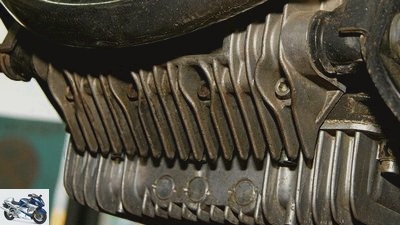
Schoch
Visual inspection: If you see traces of oil on the front of the engine below the alternator, the front crankshaft seal is usually leaking.
If the Moto Guzzi engine still loses oil after changing the oil seals, the crankshaft bearings may be worn out. “For this reason, we always check the bearing play and replace the corresponding crankshaft bearing if necessary,” explains Christian. The workload is not particularly high with the engine, which has already been removed, since only the crankshaft end shields have to be dismantled. However, if the sealing ring or bearing sliding surfaces of the crankshaft are worn in, there are another two hours of work plus 70 euros for the front and 100 euros for the rear bearing on the bill, possibly even the overhaul of the crankshaft.
However, it is difficult for laypeople to assess whether a sealing ring actually needs to be replaced. Because a slightly foggy clutch-side crankshaft seal is almost normal on these old Moto Guzzi models. To check, remove the plug from the inspection hole on the right-hand side of the clutch housing. If a greasy coating of clutch dust and oil has built up on the inside of the plug, the final death of the shaft seal may be imminent. Tip from Martin Hagemann: “Just take a look at the stopper. If the oil mist smells strongly sour, the cause can also be a defective sealing ring on the transmission input shaft. “
Another reason for leaking seals: too much engine oil. This increases the internal pressure in the engine and the oil escapes via the shaft sealing rings. If this and the ball valve of the ventilation have not yet been damaged, it is usually sufficient to lower the engine oil level to a medium level. In the models without an air filter, the ball valve sits directly in the ventilation pressure expansion tank, which is connected to the crankcase between the two cylinders via a rubber hose. The ventilation hoses of the two valve covers also end in this container. Finally, to drain the oil, a hose leads outside below the gearbox. The models with an air filter (from Moto Guzzi Le Mans III and California 2) are vented into the frame. Here the ball valve sits in the ventilation hose flange of the crankcase. Caution: If the hoses are kinked or too narrow, there is also a risk of oil leaking from the shaft sealing rings!
Only the valve cover screw connection on the cylinders occasionally causes problems, as the M6 threads cut into the bare aluminum of the cylinder head tend to tear out. Resourceful hobbyists use threaded rods as a preventive measure and screw the valve cover with hexagon socket cylinder nuts.
Valve train is considered robust
The valve train of the great Moto Guzzi V2 is considered robust. Nevertheless, a look under the two valve covers is recommended. Christian always tests the radial play of the rocker arms and checks their pressure surface for wear. Both should be in good condition even after 60,000 kilometers. “Knocked-in valves can easily be recognized by the valve clearance adjustment screws on the rocker arm that are screwed out too far. If three to five threads can be seen above the lock nut, everything is in the green, ”explains the Munich-based Guzzi specialist.
You shouldn’t forget to ask the previous owner whether hardened valve seat inserts have been retrofitted for lead-free operation. If the valves are smashed, the suspicion is that the engine is not yet lead-free. “Per capita, including material, the retrofit costs around 300 euros,” says Christian.
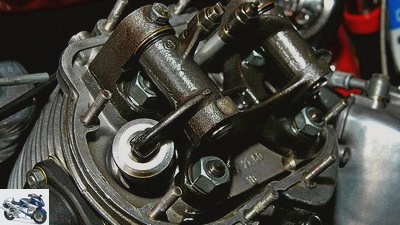
Schoch
Stud bolts are more durable than the threads of the valve cover screw connection. Resourceful screwdrivers make them themselves.
With all Moto Guzzi from the 750 S (built in 1974) you should also watch out for the noises of the timing chain, as this only has a guide rail, but does not yet have an automatic chain tensioner. To retension the long-life duplex chain, the end cover has to come down every 20,000 kilometers. An effort that many previous owners have shied away from. The consequence of the maintenance backlog is a corresponding background noise. “If you want to save yourself the need to re-tension, you can easily retrofit the automatic timing chain tensioner on later models, ie from the Quota, built in 1989,” says Christian. The tensioner costs around 100 euros plus one hour of work.
Before 1974 the V7 models had spur gears for valve control. They are completely problem-free. However, retrofitted spur gear sets often cause problems. These are still available for all models with a timing chain. “In the past, spur gears made of unsuitable material were offered that quickly wore out,” warns Christian. “If you find something like that in your Moto Guzzi, you should upgrade to the timing chain.”
All parts available for carburettors
The Moto Guzzis’ gas factories traditionally come from Dellorto. Their simple structure guarantees a long service life. “Even if something breaks, you can easily get parts or complete carburettors for every type of carburetor,” says Martin. However, you have to reckon with greater wear and tear on the carburettors of the Le Mans I and II, which are factory-fitted with open intake funnels. Depending on the operating conditions, their throttle slide can be at the end after 20 to 30,000 kilometers. Typical signs: restless idle speed and poor tuning behavior. The cause here is road dust, which works like emery paste on the innards of the carburetor.
To check, unscrew the valve cover and pull the gas valve out of the housing. In the event of excessive abrasion or scratches, a carburetor usually has to be completely replaced. Around 200 euros per piece are then due, plus assembly and synchronization. “From the condition of the carburettors you can also infer that of the engine, because the dust sucked in causes wear there too,” adds Christian and generally recommends a static pressure loss test.
Lots of chic tuning accessories for the Dellortos
There are many stylish tuning accessories for the Dellortos. Aluminum funnels are particularly popular because they look more appealing than the original gray plastic parts. If they have the same dimensions, there is nothing against their use. The plastic intake manifolds from the former Guzzi parts specialist “Moto Spezial” are also popular because, unlike the original rubber ports, they firmly connect the heavy carburettors to the cylinder head and reliably thermally decouple them. The disadvantage of these parts, which are good in and of themselves, is that they are often screwed too tightly to the head, which causes them to bend and thus draw in external air. Simple check: spray Startpilot on the intake manifold. If the idle speed increases, there are leaks here.
On the exhaust side, the mufflers must be examined in detail. The Le Mans and California models in particular often feature so-called Competizione systems from Lafranconi. “They offer a better sound and – with a good carburetor set-up – also more torque and a little more power in the middle speed range. When it comes to peak performance, however, you have to reckon with a ten percent loss, ”says Martin. “Most Competizione systems, however, lack the official TuV blessing”. However, an entry is possible when installing a front silencer. Christian offers this especially for the Le Mans models.
Martin prefers to work with slide-in catalytic converters, which reduce the noise level by around six decibels and also filter high tones. But even then, many Lafranconis still make too much noise because they rust through quickly if the motorcycle is regularly outdoors.
Clutch often with plaque
A watchful eye is also required for the clutch. If the two-disc dry clutch requires high levels of manual effort or jerks when engaging, this is often due to worn out or dirty drive teeth on the intermediate or flywheel. The drive toothing of the friction disk or transmission input shaft can also be the cause of this. If it has to be replaced, the driver teeth of the newer Guzzi models (from Moto Guzzi SP III, California III, Le Mans 1000) should always be installed. It has larger and therefore less wear-resistant gear flanks, and at around 70 euros it costs no more than the older component.
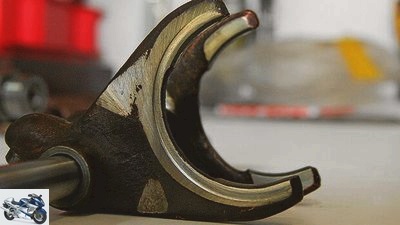
Schoch
If the gearshift forks are run in, the gears jump out again and again after shifting.
The gearbox works reliably for many years. It can usually withstand 100,000 kilometers and more without any problems before an overhaul is necessary. Nevertheless, it should be tested when buying a used vehicle. If gears jump out during the test drive or cannot be shifted exactly, the shift forks may be worn in or the toothing of the sliding sleeves may be knocked out. For the experts, however, there is no need to panic. “Most of the gearbox parts are readily available,” says Martin, “but they cost a lot of money.” Only the various needle bearings for the gearbox shafts are currently experiencing delivery problems.
The neutral switch causes trouble again and again. “It’s more of a coincidence that he works correctly,” says Christian, describing the misery. The switch consists of a contact tongue, which in the neutral position rests on a small elevation on the shift drum and thus closes the circuit. If a gear is engaged, the increase with the shift drum turns away and interrupts the circuit. “That works a thousand times over. But at some point there is still a gear engaged, despite the illuminated display, ”says the expert. “Anyone who tries to adjust the sensitive switch will quickly give up.” It was not for nothing that “Moto Spezial” once included a cover for the neutral switch for the gearbox, which closes the hole in the gearbox after the switch has been removed.
Problem child cardan
The cardan is also a real problem child. Above all, the cardan double universal joint in the swing arm mount likes to give out. In order to know for sure about its condition, it has to be removed and tested for play by hand. “This is the only way to diagnose stiff joints. If, on the other hand, the cardan joint already makes a click when it is installed, then it has already been torn off and must be replaced immediately, ”explains Martin. However, replacing the joint is relatively easy and takes around two hours. In return, the double universal joint tears a big hole in the household budget with a price of around 250 euros. “When replacing the defective universal joint, its support bearing in the swing arm should also be replaced because it was often affected by the imbalance.” However, this is not an issue with material costs of just 14 euros and a manageable extra work of a good 20 minutes.
Let’s get to the final drive. Are there any traces of oil here? Lubricant occasionally escapes, especially on the flange between the rocker arm and the final drive. The cause can be a defective shaft seal on the gearbox output shaft. However, since the final drive ventilates into the cardan tunnel in order to also lubricate the cardan length compensation, some oil mist is normal here. We also recommend checking the bevel gear shaft. If it has too much play, it must either be stored again or completely replaced. But you can only find out about such damage if you remove the flange from the final drive. One hour of work for the check and three to four hours for a possible repair are to be estimated here. When replacing the bevel gear, the crown gear also has to be replaced, which drives the repair costs to around 500 euros, including the bearing and seal kit. A job for experienced specialists, because the clearance between the ring gear and bevel gear has to be precisely spaced. “The oil in the final drive should definitely be changed annually,” advises Martin. Because of the low temperatures in the final drive, condensation can form here, which can lead to rust. When changing, never forget the prescribed molybdenum disulphide oil additive (20 ml) to reduce wear!
Better than its reputation: the electrics
Most of the Guzzi electrics come from Bosch. Alternators from Saprisa were also installed, and electric starters from Valeo on younger models. There are also electronic components from Magneti Marelli, CEV, Merit, Domino and even Ducati Energia. Since Moto Guzzi does not know exactly what was installed and when in which model due to a lack of records, it is almost impossible to check the original condition.
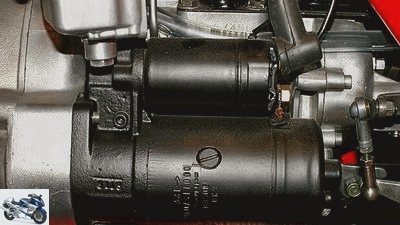
Schoch
A typical sight for all older Guzzi V-Twins: the tried and tested electric starter from Bosch.
Basically, however, the structure of the electrical system is very similar in all Moto Guzzi types. Exception: In the early V7 models, the alternator driven by V-belt (Marelli or Bosch) was placed above the crankcase between the two cylinders. Starting with the Moto Guzzi V7 Sport with the frame newly developed by Tonti at the time, the alternator was flanged to the front of the crankshaft. If the Limas of the early V7 models usually work without any problems – only the coals have to be checked occasionally – the Bosch Limas mounted on the crankshaft tend to fail, especially in the sporty Le Mans models. Then mostly vibrations added to the rotor. The damage is obvious, however, because either the generator control lamp does not go out when the engine is running, or it remains dark when the engine is stopped and the ignition is switched on because the rotor has mass. A rotor costs just under 150 euros, around an hour of work must be taken into account for the exchange.
It is cheaper with used parts, which are offered comparatively often, since the Moto Guzzi alternators are identical to those of the / 6 and / 7 models from BMW. “Damage to the Lima from overheating is rare. If, however, a decorative accessory aluminum lid is installed instead of the plastic lemonade lid and the standard plastic intermediate ventilation ring is omitted, the heat collapse is programmed, ”warns Martin. Clear indication: charred shoe plugs and melted cables on the Lima.
Overhaul of the starter
Occasionally, the oil pressure switch above the left cylinder continues to acknowledge its service. A harmless mistake that can be fixed quickly with five euros for the counter and five minutes of work. Striking electric starters can also be repaired at a similarly low cost. Often only a defective starter relay is the cause, which can be had for around ten euros. The change is done in a few minutes, even for laypeople. In the case of high mileage over 100,000 kilometers, however, an overhaul of the starter is advisable. “We clean the electric starter, measure it, repair the collectors and bearing bushes if necessary, and install new coals if necessary,” says Martin. If there is no major damage, around 100 euros are due.
Contrary to popular belief, the rest of the electrical system works quite reliably with good care. This even applies to the handlebar fittings. “Anyone who occasionally treats plugs and contacts with contact spray, lubricates the switches with Vaseline and protects their Guzzi with a breathable tarpaulin in the rain shouldn’t have any problems,” says Christian.
Difficulty with contact ignition
The same applies to contact ignition. If it has not been serviced for a long time, the result is misfiring, poor throttle response and unstable idle. In the large Guzzis, the ignition distributor is located behind the right cylinder, where the breaker contacts are under a plastic cap and the centrifugal governor, driven by a worm drive on the camshaft, is located underneath.
“The ignition contacts have a long service life thanks to the robust capacitors – the adjustment cam has to be lubricated every 3000 kilometers, otherwise the lifting lugs of the interrupter contacts will run in and the ignition point will be misaligned,” explains Christian. “The centrifugal adjustment mechanism also needs a few drops of oil on a regular basis.” When lubricating, always check the condition of the springs on the centrifugal governor. A defect can be recognized when the ignition flashes at idle speed. If the ignition marking point jumps back and forth, the springs are often overstretched. Replacement costs ten euros. If the ignition marking point in the strobe light still jumps back and forth after changing the springs, the worm drive may be knocked out. “Then the distributor pinion has to be replaced. However, this is currently no longer available. But you can revise it or replace it with a good used part, ”says Christian.
Stable to this day: the chassis
The Moto Guzzi suspensions are beyond reproach. In the past, Guzzisti used decreasing damping as an opportunity to convert to Koni struts. A good choice, as Martin confirms: “The Konis are still around today, they have been produced in Australia for several years under the brand name” Ikon “in the same quality, cost around 400 euros per pair with expert reports.” The front fork is also ex works harmoniously coordinated. If the fork oil was changed regularly, it is usually still in good condition today. If an overhaul is due, you will find recommended “tuning parts” in the accessories, such as damping elements from Bitubo or the progressive springs from Wirth.
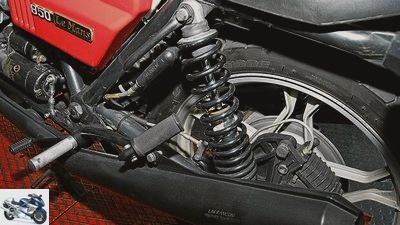
Schoch
Koni shock absorbers harmonize perfectly with the Guzzi chassis. Today they are called Ikon and are recommended replacements for the worn series shock absorbers.
The braking systems of the Mandello-Adler are traditionally supplied by Brembo. Almost all parts for repair are still there, only the rear P09 pliers on models with a pressure control valve are no longer available. Originality fanatics also have bad cards: For example, the front brake calipers of the Le Mans I are no longer available. These had two bleeding valves ex works, the current replacement brake calipers only have one. The situation is similar with the no longer available round handbrake cylinder from the first Le Mans, for which only one set of seals is offered. Only parts from Grimeca or Brembo replicas are possible replacements for the brake cylinder.
Thanks to the integral brake system, the stoppers decelerate very well even by today’s standards. The disadvantage of gray cast iron disks is their susceptibility to corrosion. “Even after a rainy night outdoors, the brake discs are rusted,” says Christian. “But that’s harmless, the first time you slow down, the rust film is down again.” The latter only becomes a problem when the vehicle is parked for a longer period of time, because oxidation scars can form on the discs under the brake pads, which can be felt by rubbing when braking. Remedy: Replacing the affected panes, costs around 150 euros per piece plus one hour of work. When visiting a Guzzi, pay attention to the long rubber brake hose of the integral brake, which usually rubs against the steering head. “If the original hoses have to be replaced, they should always be converted to steel braided lines,” recommends Martin. “Then chafing through or a spongy pressure point are no longer an issue!”
Other signs of aging
If the inspection has not revealed any serious deficiencies so far, interested buyers can start thinking about the signature. Now it’s all about the appearance. And even a layperson can easily judge this. For example, the often poor condition of the benches. In the Moto Guzzi Le Mans I to III, these are cast from molded foam. The seating furniture is mostly sat through or is disintegrating into its components. But a replacement is available, now even again for the original Le Mans for around 325 euros. The same applies to the often brittle rubber parts.
If the rear wheel of a jacked up machine is in contact with the ground, the stop of the main stand is knocked out. To repair the damage, you can either replace the stand or have the two stops welded on for little money and save 120 euros. The petrol taps should also be checked. There are two variants of this: cube-shaped on all V7 and 750 S or oval (from Le Mans I). The former in particular is often prone to incontinence and seals are no longer available. But with skill you can make them yourself.
Our two experts Christian Bauer and Martin Hagemann know even more about what to look out for when buying a used vehicle. However, these are no longer typical Guzzi ailments, but normal signs of age from which almost all classics suffer. But they still have one advice. “With hardly any motorcycle it is so important to know how the previous owner treated it,” says Christian. “If customer services were not met or only repaired when it was absolutely necessary, you should refrain from buying.” This is especially true for a tinkered machine. If you still succumb to the temptation of a low price, Martin believes that all defects should really be repaired and thoroughly restored after the purchase. “Then with good care you will have many years of peace and quiet and can enjoy the wonderful sound, the powerful draft and the good value retention of this Italian classic carefree.”
The experts
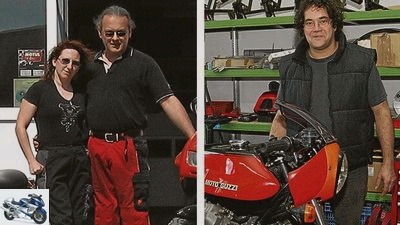
Schoch
Martin Hagemann (left) and Christian Bauer (right).
Christian Bauer has been passionate about Moto Guzzi since his early youth. At the age of 19 he bought a new Le Mans III as his first motorcycle and converted it immediately. The more he screwed on his Guzzi, the more it became clear to him that he wanted to become a Guzzi screwdriver. After successfully completing his training, he was finally given the opportunity to join IMT-Motorrader GmbH in 1988. Today Christian Bauer is one of the most sought-after Guzzi experts in Germany. From A for tuning to Z for accessories, he offers every service related to the brand from Mandello del Lario. www.imt-guzzi.de
Martin Hagemann got his driver’s license in 1982 on a Moto Guzzi V35. Since then, his heart has been beating for the little Moto Guzzi. In 1994 he founded a spare parts business especially for these models and was a Stein-Dinse depot dealer until 1999. After retraining to become a car mechanic in 1996, specializing in motorcycle repairs, the next step followed with the two-wheel mechanic master’s examination in 2000. The move to a larger workshop was due in 2007 when he found suitable and affordable premises in Hambrucken. With his wife Silke (dispatch & Office) and three other employees, he still devotes himself to the little Guzzi guys. But also the high-displacement V2 get the loving attention that the Italians need from him. www.guzziepiu.de
That’s what the restorer means

archive
Guzzi specialist Reinhard Backer from Laer.
The fan base for classic Guzzis is constantly increasing, as word has got around that you can still go on tours over the Alps or Pyrenees with the old Guzzis. Solid technology, very good chassis and brakes as well as the sound speak for themselves.
If you want to buy a large Moto Guzzi, you should first look at the tourers, because they are usually less tinkered with compared to the sports models. However, the California models from V7 to California 2 have mostly run a lot. 300,000 kilometers are not uncommon. Nevertheless, ready-to-drive T3 California cost around 4800 euros. Finding Guzzis who can be proven to have less than 100,000 kilometers on the clock is difficult. They are correspondingly expensive. Our last Cali 2 with real 37,000 kilometers went for 11,000 euros! For a T3 California that has been restored as good as new, you have to expect around 18,000 euros. The V7 models, which are sold ready to drive for around 6,000 euros, are almost all “worn out, although they are very stable motorcycles. The prices of sports models in particular have risen sharply in recent years. A tinkered Le Mans I easily costs 8,000 euros, for a perfectly restored one we even pay up to 30,000 euros. V7 Sport and 750 S to S3, on the other hand, are hardly available anymore, but definitely a good investment, as 35,000 euros are spent on a V7 Sport.
Moto Guzzi Le Mans IV is still being traded cheaply
A Moto Guzzi Le Mans II, on the other hand, is much cheaper – ready-to-drive specimens are available from 7,000 euros. But unfortunately it doesn’t look that nice. Because of this, many machines were rebuilt. The Le Mans III is certainly the classic of the future and is still relatively original on the market. Good running machines are around 6000 euros. A Le Mans IV is still cheap. Ready to drive, it costs around 3000 euros.
In general, caution is advised when buying used sports models because they have been tuned and rebuilt a lot – and unfortunately rarely by a specialist! Restoration and servicing of the classic Guzzi models are pretty straightforward. The important spare parts that are needed for driving are still available in abundance thanks to the modular system. Model-specific parts, such as indicators, light switches, headlights or seats, are hard to find in good quality. The prices rise accordingly. For example, a light switch for the Le Mans I costs an impressive 200 to 250 euros per side! www.motoguzzi-baecker.de
market

archive
Frank Wilke, Head of Market Monitoring at classic-car-tax.
The price level of the great Moto Guzzi of the 1970s and 80s shows a clear characteristic: whether V7, 850, 1000 or Le Mans, there are no gigantic price differences. As a rule of thumb, athletes are more expensive than tourers. In any case, the few outstanding models in terms of value include the 850 California, 750 Spezial, the 750 Ambassador, which was only built for the USA, and above all the V7 Sport. Anyone who wants the “Telaio Rosso” version, which was only built from 1971 to 1972, should be prepared for a long search and a hefty surcharge, which can be up to 10,000 euros above the value of a normal Moto Guzzi V7 Sport.
With volume models like the 850 tourers, on the other hand, the potential for value appreciation is limited. Very important: original condition. Already converted seats can be a deterrent, repainted machines cannot even be sold at the price, at least at dealerships, even if unmodified Moto Guzzi Le Mans I are almost extinct. This buying behavior is primarily related to the changed group of buyers: In addition to the do-it-yourselfers in their mid-40s who have seen these Guzzi models new or as young used ones, younger and financially well-off collectors have been joining the group for some years now, who have, with the greatest possible degree of naturalness, extensive restorations order – but in the original condition, please.
Screwdriver skills

archive
Required screwdriver skills for independent repairs on a Moto Guzzi.
With its maintenance-friendly and relatively clear structure, a Moto Guzzi is traditionally one of those motorcycles that people like to screw on a lot. Nevertheless, the Italian cardan machines also demand a good deal of experience from the hobby screwdriver and an appropriately equipped workshop. For a realistic self-assessment, we show here what demands the V2 classics place on the do-it-yourselfer in order to be able to cope with typical work successfully.
More Moto Guzzi specialists
The Motothek,
73577 Birkenlohe, phone 071 76/37 29
www.daes-motothek.de
Dynotec GmbH,
67592 Florsheim, phone 062 43/58 82
www.dynotec.de
Gawa Guzzi GmbH,
66129 Saarbrucken, phone 068 05/21 88 29
www.gawa-guzzi.de
HMB-Guzzi,
91187 Rottenbach, Tel. 091 72/66 99 18
www.hmb-guzzi.de
MTS Ricambi,
26203 Wardenburg, Tel. 044 07/207 18
www.mts-ricambi.de
Michael Nitzsche & team,
46286 Dorsten, phone 023 69/218 42
www.italomotos.de
Peter Lamparth,
73287 Bad Boll, phone 071 64/140 37
www.mgc-lamparth.de
Stein-Dinse (Guzzi / Brembo parts),
Online shop: www.stein-dinse.biz
Related articles
-
Advice on used large V-Twins from Moto Guzzi
fact counselor Used purchase Advice on used large V-Twins from Moto Guzzi Advice on used large V-Twins from Moto Guzzi Survival artist Despite torque…
-
Driving report Moto Guzzi V7: More relaxed with thicker cheeks
News 2022 New motorcycle items for 2022 Moto Guzzi 32 pictures Moto Guzzi 1/32 Moto Guzzi is significantly up-dating the V7. The 850 twin from the V9 and…
-
Second hand advice Moto Guzzi Griso
manufacturer 8th pictures archive 1/8 Moto Guzzi Griso 8V Strong four-valve bull with 110 horses. archive 2/8 Moto Guzzi Griso 850 Same chassis, but less…
-
Fred Siemer Sports & scene Scene: Moto Guzzi Baker Scene: Moto Guzzi Baker The workshop of the Guzzi specialist Content of Anyone who trades with Moto…
-
On the move with the BMW R 90 S, Moto Guzzi Le Mans and Triumph Bonneville
Rein van der Zee 13th pictures Rein van der Zee 1/13 Top and bottom: At Saint-Martin, a narrow hanging structure spans the Ardèche. This is where the…
-
Gargolov 14th pictures Gargolov 1/14 Harley-Davidson 1200 Custom, Kawasaki W 800, Moto Guzzi Bellagio, Triumph Scrambler: With these four classic bikes,…
-
Moto Guzzi in the 2020 model year
Moto Guzzi. 15th pictures Moto Guzzi. 1/15 Moto Guzzi V85 TT. Price: from 11,990 euros. Moto Guzzi. 2/15 Moto Guzzi V85 TT Travel. Price: from 13,490…
-
Moto Guzzi Classics in California
Blacksmith 19th pictures Blacksmith 1/19 Old-school Guzzi screwdriver Mark Etheridge. Blacksmith 2/19 One last look at the hodgepodge, then ……
-
ZepGori 17th pictures Michael Orth 1/17 Machine 11: based on Le Mans 3, 950 cm3, 82 hp, weight 184 kg. Michael Orth 2/17 Finished conversions are…
-
Moto Guzzi turns 100: Adler von Mandello celebrates its anniversary
Moto Guzzi 16 pictures Moto Guzzi 1/16 Moto Guzzi is celebrating its 100th birthday and is launching special Centenario models. Moto Guzzi 2/16 A satined…